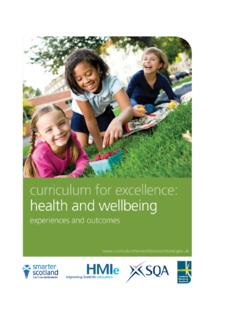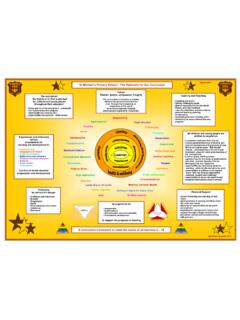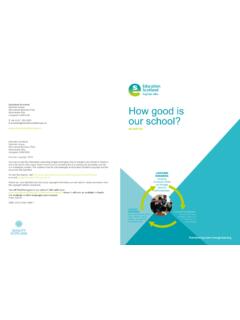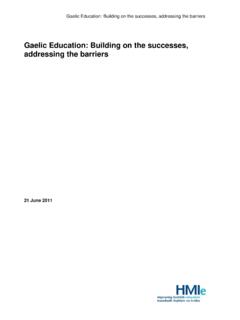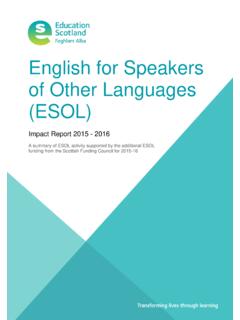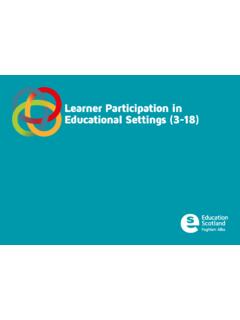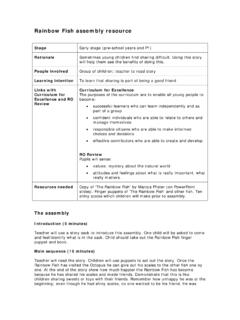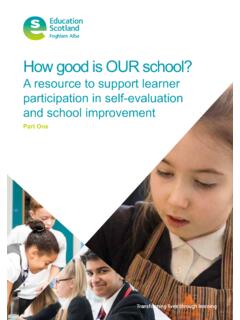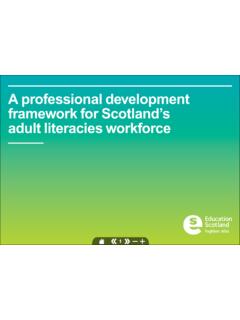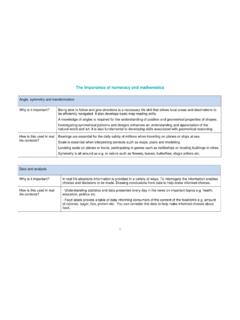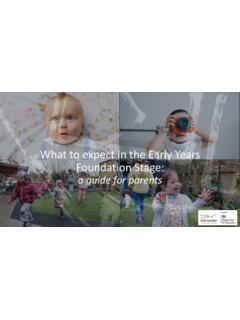Transcription of How good is our early learning and childcare?
1 How good is our early learning and childcare ? February 2016 Contents How good is our early learning and childcare ? .. 2 The Quality Indicators .. 5 Leadership and Management ..11 learning Provision ..22 Successes and Achievements ..39 Appendix 1: The six-point scale ..47 Appendix 2: Glossary of Terms ..49 Helpful contacts and resources ..53 Please note that the following terminology is used throughout this framework: Setting - is a single term which encompasses all establishments, including a childminding service which delivers early learning and childcare for children aged 0 - until they start primary school . Parents and carers - includes all adult individuals who have a legal responsibility for a child aged 0-5 years.
2 Practitioners - is a single term which includes all staff and adults who work with children under 5 yearsold until they start school and includes childminders, teachers, managers, supervisors, support and out ofschool care | 1 How good is our early learning and childcare ? How good is our early learning and childcare ? Context Self -evaluation for self-improvement has been a feature of improving the early years sector of Scottish education for our youngest children in Scotland for many years. As members of the early learning and childcare sector, we have used our previous self-evaluation frameworks as a tool to help in the process of self-evaluation for settings to improve their quality and aim for excellence.
3 We have become very familiar with the use of quality indicators, which has been a key feature to influence our practice for the benefit of children s outcomes. This new framework, How good is our early learning and childcare (HGIOELC), seeks to build on this positive response but at the same time take a fresh look at the developing needs and reflect the changes and increased provision of the ELC sector today. For the first time, this framework will only be published as a digital resource on the new National Improvement Hub. This gives Education Scotland the opportunity to offer truly interactive digital resources for our future improvement frameworks and tools that can be developed and updated flexibly.
4 In April 2014, The Children and Young People (Scotland) Act was introduced with a renewed focus on children from birth to starting school . This focus highlighted the importance of ELC for the future of individual children, their families and practitioners in the varying types of settings throughout Scotland. Recent changes in approach and policy direction have been the conduit for change to our existing self-evaluation materials. HGIOELC takes account of the continuous aspiration to make Scotland the best place to grow up, and embraces the diversity and type of provision across the country. HGIOELC takes account of childminders, all private, voluntary and local authority settings.
5 It is therefore for all practitioners working with children from birth to starting school . It complements the newly published How good is our school ? (4th edition), for primary and secondary schools, and underpins the approach to self-evaluation to drive forward improvement work across Scotland. It takes full account of recent policy initiatives such as, National Practice Guidance on early learning and childcare : Building the Ambition, Pre-birth to Three, Getting it right for every child and Curriculum for Excellence. Why we need a new framework Evidence on the current performance of Scotland s education system suggests that we have a good education system, which is performing strongly in a number of respects.
6 However, we are not yet at the level of achieving consistently excellent levels of performance which would match the world-leading ambition of our vision Education Scotland Corporate Plan 2013-2016 Partnership working between key organisations supporting early learning and childcare (ELC) in Scotland is a clear and defining strength and we are in a unique time where the emphasis on working with our youngest children has never been given such prominence. The Programme for Scottish Government has identified some significant priorities for the next stage of our improvement journey, including increasing the provision of early learning and childcare to improve outcomes for children, developing the ELC workforce, Developing Scotland s Young Workforce and the Scottish Attainment Challenge.
7 Closing the gap in children s attainment, achievement and wellbeing between children living in our most and least deprived areas is a key challenge for the wider Scottish agenda. We know that physical, social, emotional and economic wellbeing have a significant impact on our youngest children s successes and achievements throughout their life. This new framework How good is our early learning and childcare ? provides an important contribution to support those working in the ELC sector and system-wide improvement alongside this significant and exciting agenda. Page | 2 How good is our early learning and childcare ? Partnership, c ollaboration and self -improvement Meeting the wide-ranging needs of all children and their families is the heart of what makes excellent provision.
8 Settings cannot achieve this by themselves. How good is our early learning and childcare ? highlights the importance of partnership and collaboration as significant features of a highly effective setting. For example, parents and carers have unique experience of their children and have important knowledge of their progress as learners over time within the ELC setting, at home and in other aspects of a child s life. It is important that their views on the setting are taken into account, from what they see on an informal daily basis, what help and support and response they may receive at times of difficulty or concern, and by generally gathering their views on the impact of improvement.
9 A note about the term self-evaluation The term self-evaluation is used to cover the way in which individuals and settings explore their progress, development and practice to identify what has improved and what still needs to improve. It is a way of using evidence to assess achievements and success and areas that still need action. The significant relationship between effective self-evaluation and improvement might also be understood to help settings answer the familiar three questions, which remain at the heart of self-evaluation: How are we doing? How do we know? What are we going to do now?Settings well on their way to excellence focus these questions on the core business of the setting to promote learning and development for children.
10 It is important to have reasons for evaluating the areas you have chosen and the evidence on which you base your evaluations kept manageable. Key sources of evidence will come from, for example, what you actually observe, from data of various kinds and collating the views of people who actually are involved with the setting, such, parents and carers, partner agencies, practitioners and the children themselves. It is important not to underestimate the contribution of children, as they provide a thoughtful and valuable perspective of their experiences. You may want to gather their views by talking individually or in a small group, watching and listening to how they play, making observations of their progress and seeing how they respond to adult interaction.
